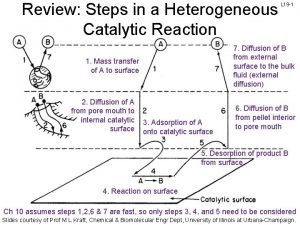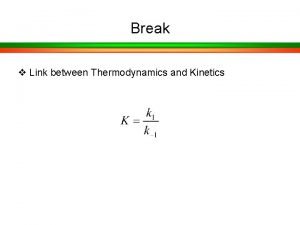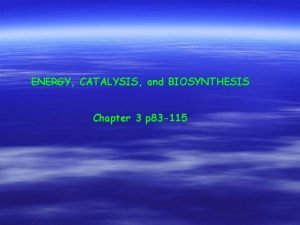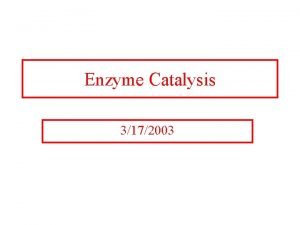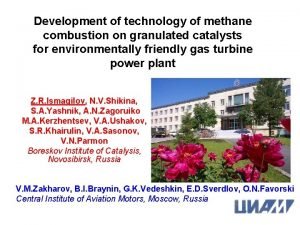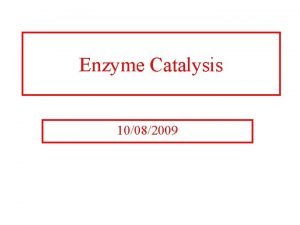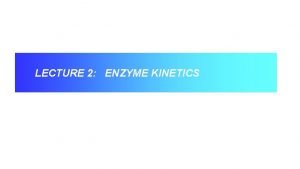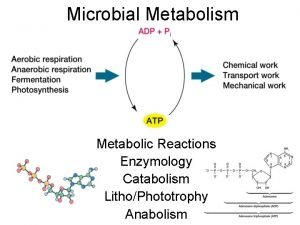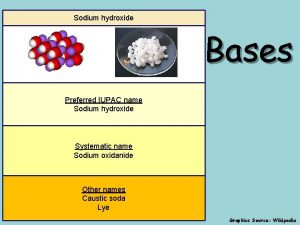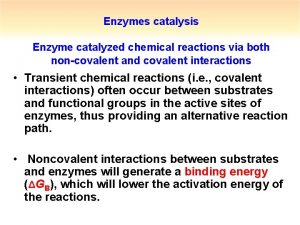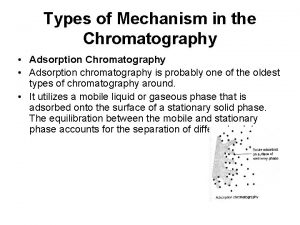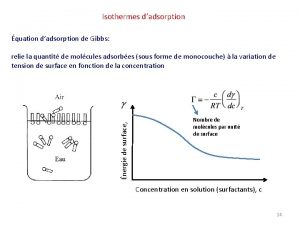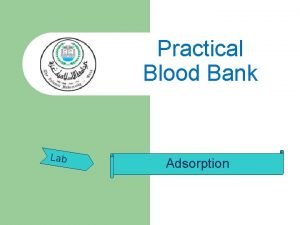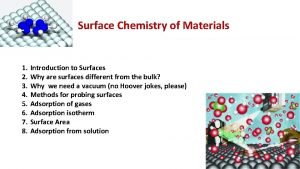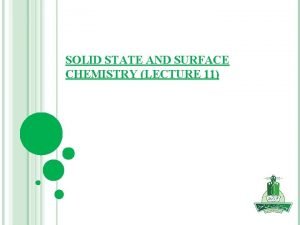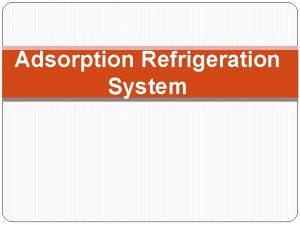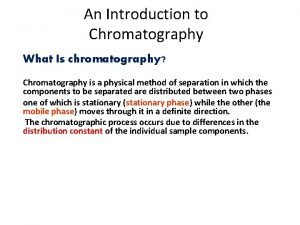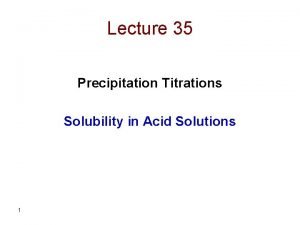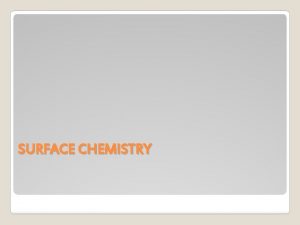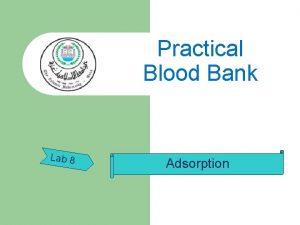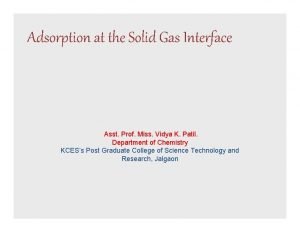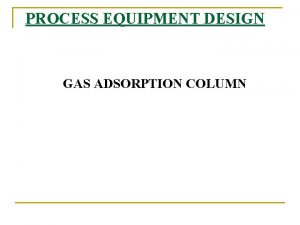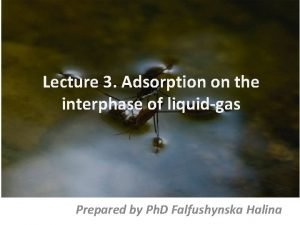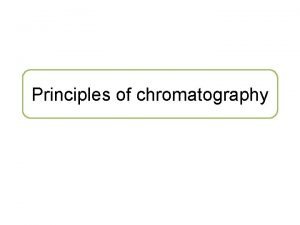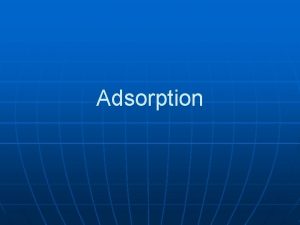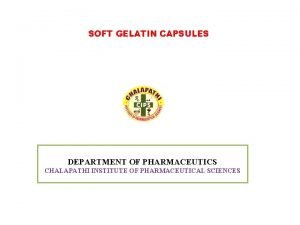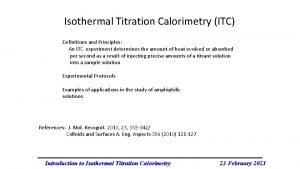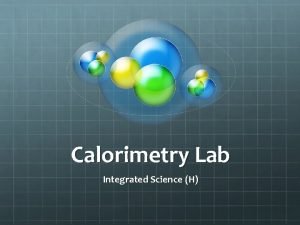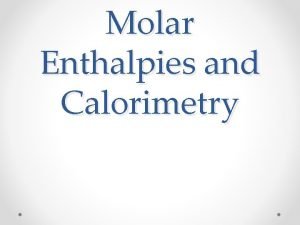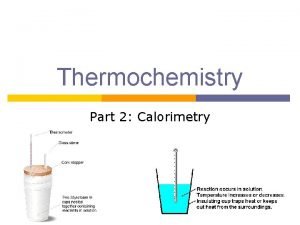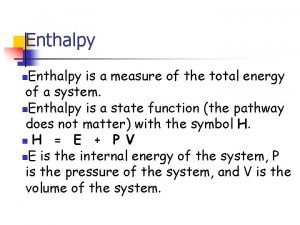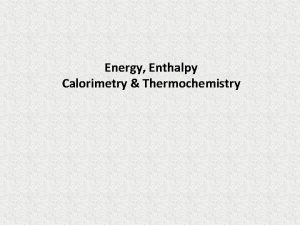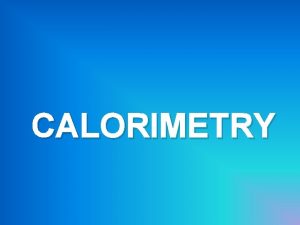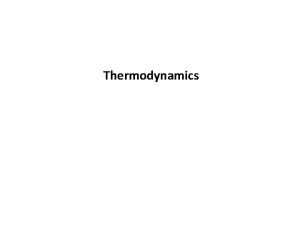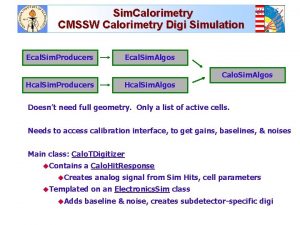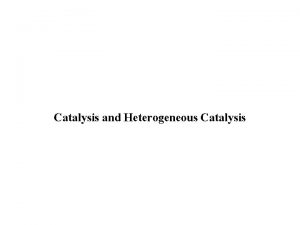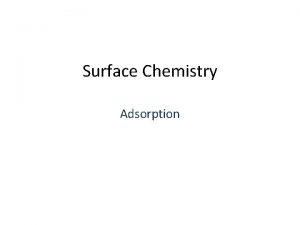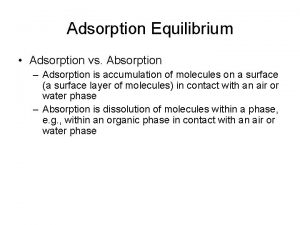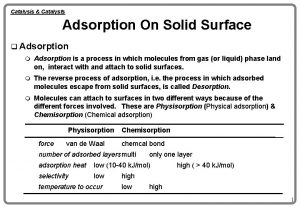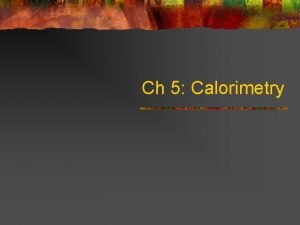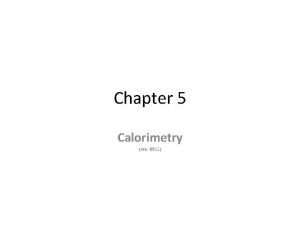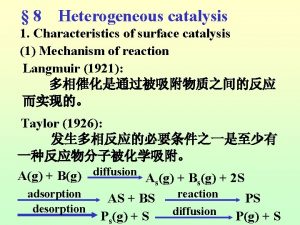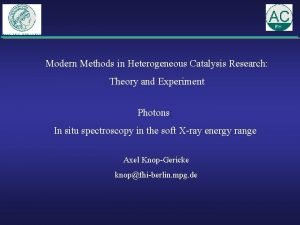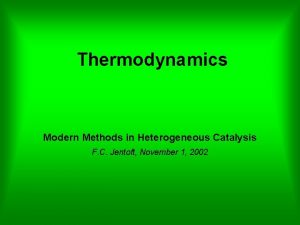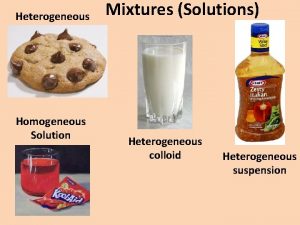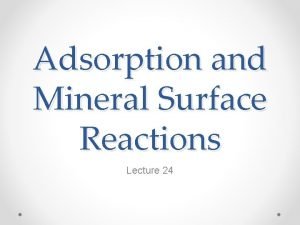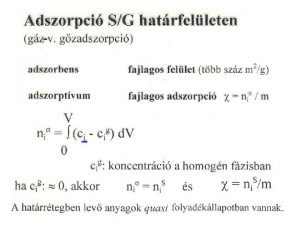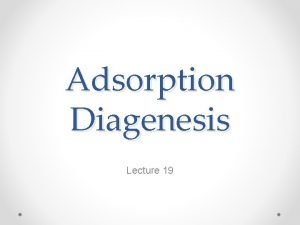Adsorption Calorimetry Modern Methods in Heterogeneous Catalysis F
































![Power v The power P [W] necessary to heat the cell by d is Power v The power P [W] necessary to heat the cell by d is](https://slidetodoc.com/presentation_image_h/81b76f26635544eba7063cb552dd56f3/image-33.jpg)

![The Tian Equation v G [W/K] is constant and if C [J/K] can be The Tian Equation v G [W/K] is constant and if C [J/K] can be](https://slidetodoc.com/presentation_image_h/81b76f26635544eba7063cb552dd56f3/image-35.jpg)













- Slides: 48

Adsorption Calorimetry Modern Methods in Heterogeneous Catalysis F. C. Jentoft, November 22, 2002

Outline v Motivation v Heat of adsorption v Volumetric System Calibration of volume Measurement of adsorbed amount v Calorimeter Calibration of calorimeter Measurement of heat signal

Motivation: Surface Sites Brønsted-sites OH-groups (acidic/ basic) Lewis-sites coordinatively unsaturated (cus) metal cations (acidic) oxygen anions (basic) Metal Sites Questions: Type? Number / density? „Strength“ (interaction with a certain molecule)?

Probing Surface Sites by Chemisorption adsorption H calorimetry + NH 3 desorption T TDS/TPD IR, XPS, NMR, UV/Vis. . . shift of bands (probe/surface)

Specific Adsorption (Chemisorption) A B C v Physisorption (e. g. N 2) yields geometric surface area A B C v Specific adsorption / chemisorption gives information about a particular type of site which depends on the type of probe used A, B can be distinguished, B and C can maybe distinguished

Integral Heat of Adsorption v A probe may chemisorb on different sites under production of different heats of adsorption v If all sites are covered at once, the evolved heat will be an integral heat v if the number of adsorbed molecules is known, an average / mean heat of adsorption can be calculated

Differential Heats of Adsorption v Sites can be covered step by step, e. g. 1. 2. 3. v Differential heats of adsorption as a function of coverage can be determined v A general concept: example dissolution “first”, “last” heat of dissolution = differential heats

Adsorption Calorimetry v The sorptive must be introduced stepwise, i. e. at constant temperature, the pressure is increased slowly v For each adsorption step, the adsorbed amount must be determined (isotherm) v For each adsorption step, the evolved heat must be determined v The differential heat can then be determined by division of evolved heat through number of molecules adsorbed in a particular step

Measurement of the Adsorbed Amount v via the pressure decrease through the adsorption (no change in number of molecules in system during adsorption) v via increase in sample weight v via the evolved heat (if heat of adsorption known and constant) v spectroscopically (if extinction coefficient of adsorbed species known)

Pressure Decrease Method v A known number of molecules of the sorptive is introduced into the sample cell v The sorptive is distributed into three partitions: gas phase, wall adsorption, sample adsorption v the equilibrium pressure with sample is compared to the equilibrium pressure without sample at equal number of sorptive molecules in the cell v from the pressure difference the number of adsorbed molecules can be calculated

Dosing a Known Amount of Gas v A known number of molecules of the sorptive is introduced into the sample cell v If we know the volume, temperature and pressure, we can calculate the number of gas molecules v Need V, T, p

The Dosing Volume pressure gauge dosing system DOSING VOLUME vacuum gas in v p, T can be easily measured v V needs to be determined

Volume Calibration v A volume can be measured by determining the amount of liquid that it can take up a) gravimetrically: weight / density of liquid b) volumetrically: add liquid from a burette v An unknown volume of any shape can then be determined through expansion from gas (an ideal gas that does not stick much to the walls) from one volume to the other and pressure measurement before and after the equilibration

Calibrating the Dosing Volume pressure gauge dosing system DOSING VOLUME VDos vacuum gas in CALIBRATION VOLUME VCal v fill VCal and VDos, same pressure v close valve between VCal and VDos v set pressure in Vdos to p. Dos v open valve, equilibrate

Calibrating the Dosing Volume pressure gauge dosing system DOSING VOLUME vacuum gas in v Initial situation: v After opening valve: v n, T are constant CALIBRATION VOLUME

Example Data v It is important that the entire system is at the same constant temperature!

Calibration and Dosing System

Determining the Dosed Amount pressure gauge dosing system DOSING VOLUME vacuum gas in CALIBRATION VOLUME CELL VOLUME sample cell

The Cell

Total Number of Molecules in Sample Cell v Total number of molecules accumulated in cell v i. e. the sum of the number of molecules already in the cell the number of molecules introduced in the ith step

Empty Cell: The Wall Adsorption v Molecules are in the gas phase but also adsorbed on the wall surface v Only the gas phase molecules contribute to the measured pressure v The number of molecules adsorbed on the walls depends on the pressure

Volumetric-Barometric System pressure gauge dosing system DOSING VOLUME vacuum CALIBRATION VOLUME gas in CELL VOLUME sample cell pressure gauge sample cell

Wall Adsorption Blank Measurement v Measure the pressure in the cell as a function of the total number of molecules introduced into the cell v Without wall adsorption and without sample, the relation between pressure and number of molecules in the sample cell would be given by the ideal gas law

Wall Adsorption Blank Measurement v With wall adsorption and with or without a sample, the relation between number of molecules in the gas phase + on the walls and the pressure can be written as a polynomial expression v Without a sample, the coefficients can be determined

Example Blank Measurement Nr p. Dos, bef/ mbar 1 9, 682 2 9, 653 3 9, 607 4 9, 562 5 9, 499 6 9, 442 7 9, 392 9 9, 230 10 9, 128 11 9, 024 13 8, 814 14 8, 644 15 8, 466 16 8, 209 17 7, 783 19 6, 672 20 5, 893 21 4, 477 22 9, 146 p. Dos, aft/ mbar 9, 674 9, 641 9, 591 9, 544 9, 481 9, 428 9, 371 9, 195 9, 091 8, 988 8, 758 8, 582 8, 386 8, 122 7, 612 6, 487 5, 526 4, 041 8, 409 p. SC, i / mbar 0, 007 0, 026 0, 054 0, 081 0, 117 0, 147 0, 181 0, 283 0, 344 0, 403 0, 537 0, 640 0, 755 0, 909 1, 208 1, 870 2, 436 3, 314 4, 056 nint, i/ µmol 0, 04 0, 06 0, 08 0, 09 0, 07 0, 11 0, 18 0, 19 0, 29 0, 32 0, 45 0, 90 0, 97 1, 93 2, 30 3, 88 n. SCtot, i / µmol 0, 04 0, 10 0, 18 0, 27 0, 36 0, 43 0, 54 0, 72 0, 91 1, 10 1, 39 1, 71 2, 13 2, 58 3, 45 5, 38 7, 68 11, 56

Correction for Wall Adsorption v The adsorption of isobutane on the walls is insignificant

Calculation of Adsorbed Amount v Total number of molecules in sample cell after the ith step v Total number of molecules in sample cell after the (i+1)th step v The difference in number of molecules between ith and (i+1)th step is the number of molecules introduced in the (i+1)th step

Calculation of Adsorbed Amount v T number of molecules adsorbed in the (i+1)th step is then v The total number of molecules adsorbed after (i+1) steps is

Raw Data Pressure

The Adsorption Isotherm

The Calorimetric Element v The sample cell is placed into a calorimeter element v The cell is surrounded by a thermopile made of more than 400 thermocouples in series v Thermopile has 2 functions: transfers heat generates signal

Heat and Heat Flow v The heat produced by the reaction is consumed by two processes 1. Increase of the temperature of the sample cell 2. Once there is a temperature gradient between cell and surrounding block, heat flow through thermopile
![Power v The power P W necessary to heat the cell by d is Power v The power P [W] necessary to heat the cell by d is](https://slidetodoc.com/presentation_image_h/81b76f26635544eba7063cb552dd56f3/image-33.jpg)
Power v The power P [W] necessary to heat the cell by d is proportional to the heat capacity C [J/K] of the cell v The heat flow [power] is proportional to the temperature gradient between cell and block and to thermal conductance G [W/K] (thermischer Leitwert)

Power Balance and Signal v Total thermal power of cell v The electrical signal is proportional to the temperature difference v The relation between power and electrical signal is then
![The Tian Equation v G WK is constant and if C JK can be The Tian Equation v G [W/K] is constant and if C [J/K] can be](https://slidetodoc.com/presentation_image_h/81b76f26635544eba7063cb552dd56f3/image-35.jpg)
The Tian Equation v G [W/K] is constant and if C [J/K] can be considered constant, then C/G is a constant with units of time v The Tian equation shows that the power is not proportional to the temperature difference, the power is delayed with respect to the signal U produced by the cell

Reference Cell Setup according to Tian and Calvet Setup according to Petit

Complete System pressure gauge dosing system DOSING VOLUME vacuum CALIBRATION VOLUME gas in vacuum CELL VOLUME reference cell sample cell pressure gauge sample cell

The Calorimeter

Calculation of Evolved Heat v If heat is released in the cell for a limited period of time, e. g. through adsorption, then a signal with an exponential decrease is obtained for U v The integral under the curve is proportional to the evolved heat v A: area under curve [Vs] v f: calibration factor [J/(Vs)]

Calibration Procedure v The calorimeter can be calibrated in two different ways, easily achieved by using an Ohm resistance: 1. Constant power 2. Produce a certain amount of heat, Q = U*I*t v Disadvantage of the electrical calibration: heat transfer through wiring! v Calibration by chemical reaction

Calibration Data v The calibration factor is temperature dependent v Check for linearity

Calibration Data

Raw Data: Equilibrium Pressure and Thermosignal

Example 1: Propane Adsorption on Sulfated Zirconia

Example 2: Ammonia Adsorption on Heteropolyacids v H 3 PW 12 O 40 * x H 2 O reaction with ammonia

Literature v A. Auroux “Thermal Methods: Calorimetry, Differential Thermal Analysis, and Thermogravimetry” in “Catalyst characterization: physical techniques for solid materials”, Eds. B. Imelik, J. C. Vedrine, Plenum Pr. , New York 1994 FHI 28 I 57 v E. Calvet, H. Prat, H. A. Skinner “Recent progress in microcalorimetry”, Pergamon Pr. , Oxford 1963 FHI 6 Z 17

Multiple Adsorption Steps, Generation of Isotherm v The total number of molecules in the cell is determined by addition of the amounts introduced in each single step v The isotherm is created by plotting the adsorbed amount vs. the equilibrium pressure

Example 2: Ammonia Adsorption on Heteropolyacids
 7 steps of heterogeneous catalysis
7 steps of heterogeneous catalysis Langmuir-hinshelwood mechanism heterogeneous catalysis
Langmuir-hinshelwood mechanism heterogeneous catalysis Specific acid base catalysis
Specific acid base catalysis Energy catalysis and biosynthesis
Energy catalysis and biosynthesis What is covalent catalysis
What is covalent catalysis Specific acid base catalysis
Specific acid base catalysis Site:slidetodoc.com
Site:slidetodoc.com What is covalent catalysis
What is covalent catalysis Enzyme catalyze
Enzyme catalyze Metabolism
Metabolism Hydroxide catalysis bonding
Hydroxide catalysis bonding Specific acid base catalysis
Specific acid base catalysis Difference between atomic and molecular spectroscopy
Difference between atomic and molecular spectroscopy Catalysis by approximation
Catalysis by approximation Direct wax pattern
Direct wax pattern Mechanism of adsorption chromatography
Mechanism of adsorption chromatography Substance launcher
Substance launcher Les types d'adsorption
Les types d'adsorption Adsorption technique in blood banking
Adsorption technique in blood banking Adsorption introduction
Adsorption introduction Chromatography mobile phase and stationary phase
Chromatography mobile phase and stationary phase Langmuir adsorption isotherm definition
Langmuir adsorption isotherm definition Langmuir adsorption isotherm
Langmuir adsorption isotherm Von weimarn ratio
Von weimarn ratio Adsorption refrigeration cycle
Adsorption refrigeration cycle Adsorption
Adsorption What is chromatography? *
What is chromatography? * Agscn dissociation
Agscn dissociation Adsorption phenomenon
Adsorption phenomenon Adsorption technique in blood banking
Adsorption technique in blood banking Wet gum method and dry gum method
Wet gum method and dry gum method Solid gas interface
Solid gas interface Adsorption in physical pharmacy
Adsorption in physical pharmacy Adsorption column design
Adsorption column design Langmuir adsorption isotherm
Langmuir adsorption isotherm Slidetodoc.com
Slidetodoc.com What is adsorption
What is adsorption Difference between hard and soft gelatin capsule
Difference between hard and soft gelatin capsule Eosin adsorption indicator
Eosin adsorption indicator Bomb calorimetry equation
Bomb calorimetry equation Isothermal titration calorimetry principle
Isothermal titration calorimetry principle Food calorimetry lab
Food calorimetry lab Calorimetry lesson
Calorimetry lesson Bomb calorimeter
Bomb calorimeter Constant pressure calorimetry
Constant pressure calorimetry Hess law constant heat summation
Hess law constant heat summation How to calculate delta h with temperature
How to calculate delta h with temperature Bomb calorimeter equation
Bomb calorimeter equation Pearson calorimetry simulation
Pearson calorimetry simulation
